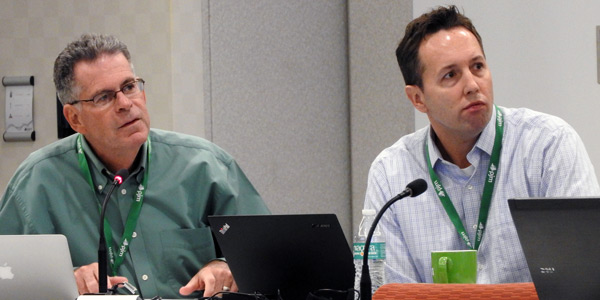By Rory D. Sweeney
WILMINGTON, Del. — Solutions for reducing uplift charges have been more than four years in the making, so PJM members at last week’s Markets and Reliability Committee meeting were largely unconvinced when financial traders argued that voting on the solution’s third phase was being rushed.
Financial stakeholders campaigned unsuccessfully for more than an hour to change the proposal.
Stakeholders then approved a package designed by PJM “to strike a balance between retaining the theoretical benefits of virtual trading while eliminating opportunities for virtual transactions to profit from the market without providing those benefits.” It limits incremental offers and decremental bids to “locations where the settlement of physical energy occurs,” where they compete directly with physical assets or trading hubs, where traders can take forward positions.
Up-to-congestion transactions would be limited to hubs, zones and interfaces — locations that are large aggregates. PJM said the change will address concerns that some UTC trades “do not benefit the market at a level commensurate with the profitability of the transactions.” (See “Members Approve Uplift Proposals,” PJM Markets and Reliability and Members Committees Briefs.)
Financial stakeholders mounted several efforts to influence the vote. They first called for deferring it until FERC has acted on Phase 2, which failed in a sector-weighted vote with 1.04 in favor. The MRC requires a two-thirds sector-weighted vote (3.33 out of 5). Only the Other Supplier sector — which includes financial traders — was in favor of the delay, with the other sectors almost unanimously opposed.
Attorney Ruta Skucas, who represents the Financial Marketers Coalition, called for the deferral, which was seconded by Joe Wadsworth of Vitol. Skucas said the proposal was changed significantly shortly before it went to vote and never received vetting at the Energy Market Uplift Senior Task Force, where the issue had been hashed out for years. The changes eliminated all but 41 nodes for UTCs, she said.
Wadsworth described the proposal as taking “a sledgehammer to the market,” saying the root issue was modeling errors that could be addressed by a more “surgical” approach, such as eliminating trading at locations where the day-ahead and real-time models can’t be aligned.
“When we start removing what traders can do in managing their portfolios on a day-ahead and real-time basis, we’re going to take away the uniqueness traders bring that leads to competition in the markets,” he said.
Bruce Bleiweis of DC Energy also supported a delay, saying he’s been involved with PJM for 21 years, and “this is the first time we’ve come to a rush to judgment.”
Other stakeholders disagreed.
“My clients would have a different opinion of that,” said attorney Susan Bruce, who represents the PJM Industrial Customer Coalition. “This is a solution that’s a long time coming.”
Direct Energy’s Jeff Whitehead took exception to the accusations of rushed voting.
“I believe this issue has seen its day in court. There are buses that are available to virtual traders on the system today … where there are modeling issues between the day-ahead and real-time market. And because those modeling issues ostensibly can’t be corrected by PJM, arbitrage opportunities exist that simply cannot be converged between the two markets,” he said. “If traders are simply trading with themselves at points that cannot converge, I don’t call that a market.”
“The purpose of the markets is to provide real power to real customers at the lowest possible cost,” said Joe Bowring, PJM’s Independent Market Monitor. “To the extent that virtual transactions are not contributing to that, it’s not appropriate to allow them to continue.”
PJM’s Adam Keech agreed, saying that rules for virtual trading are designed to have the “highest probability of adding the most to the system.”
PJM staff said it’s not clear when the proposal will be filed with FERC because contested filings require a quorum of commissioners to resolve, and the filing seemed likely to attract protest. Noha Sidhom, a financial trader who doesn’t participate in the virtual market, then proposed bifurcating the package into separate filings so that the noncontroversial portions — the limits on INCs and DECs — could be approved by FERC staff and implemented, while the UTC changes — which likely will receive protest — can wait until the commission has a quorum.
Stakeholders debated for some time whether that proposal should be considered prior to voting on the original package, and eventually determined that it should not. The original proposal passed with a 4.07 sector-weighted vote, with all but the Other Suppliers in support.




